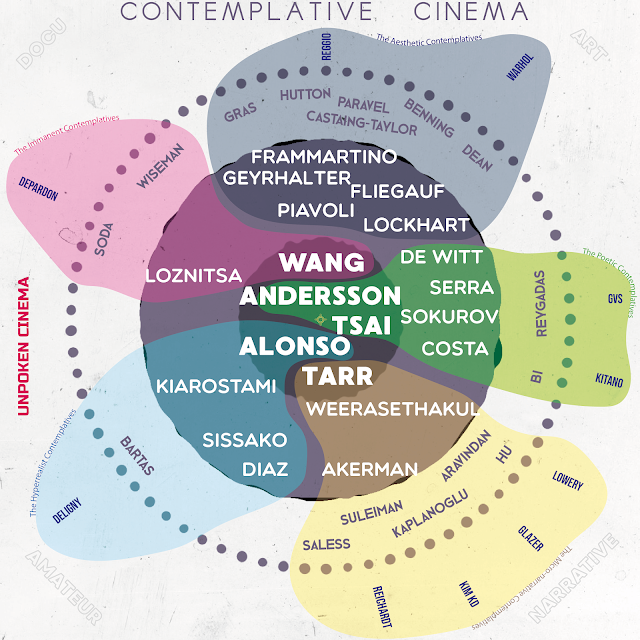Contemplative Core & Tectonic Plates
The core figures of Contemplative Cinema could be summed up by the names: WANG Bing, Roy ANDERSSON, TSAI Ming-liang, Lisandro ALONSO, and Béla TARR, for being consistently, profoundly, and magnificently contemplative... (See Iconic Directors of Contemplative Cinema)
Out of the minimalist centre radiate trustworthy rings of authentic contemplatives, up to the far reach of more conventional edges, maybe more "slow" than "contemplative”, but still minimalist. However, under this uniting banner of “Contemplative Cinema” surges the distinctive rifts between the tectonic plates of more cohesive sub-divisions… because it’s crucial to extract their diversity from their resemblance, their personality from their unity.
From this widespread of satellites emerges 5 more stylistically coherent sub-families sorted by affinity tending towards "Art" (Art Gallery and Minimalist Formalism), "Narrative" (but still Minimalist), "Amateur" (Minimalist Hyperrealism) and "Docu" (Minimalist Documentary). Instead of resorting to a wide ranging net, like the umbrella term "Slow Cinema" which keeps on accumulating new names from all directions, from the past, from the margins, from the newcomers… it is important to take a hard look into the particularities of this group of minimalist auteurs (Contemplative Cinema) and highlight their differences in more restricted identifiable sub-groups:
A. Between documentary and art: The Aesthetic Contemplatives
- (none)
- Franco Piavoli, Sharon Lockhart, Bence Fliegauf, Nikolaus Geyrhalter, Michelangelo Frammartino,
- Emmanuel Gras, Peter Hutton, Verena Paravel/Lucien Castaing-Taylor, James Benning, Tacita Dean,
- Godfrey Reggio, Andy Warhol
- Their precursors are Ruttmann, Ivens, Savage, Vigo, Pollet.
- Their prototype is Warhol (Empire, Sleep).
- An iconic feature would be Le Quattro Volte.
B. Between art and narrative: The Poetic Contemplatives
- Roy ANDERSSON, TSAI Ming-Liang,
- Albert Serra, Aleksandr Sokurov, Pedro Costa, Dudok De Witt,
- Bi Gan, Carlos Reygadas,
- Takeshi Kitano, Gus Van Sant
- Their precursors are Deren, Tati, Bresson.
- Their prototype is Sokurov (Mother and Son).
- An iconic feature would be Songs from the Second Floor.
C. The minimalist narrative: The Micro-narrative Contemplatives
- Béla TARR,
- Apichatpong Weerasethakul, Chantal Akerman,
- Sohrab Shahid Saless, Elia Suleiman, Semih Kaplanoglu, Govindan Aravindan, Hu Bo,
- Kelly Reichardt, Kim Ki-duk, David Lowery, Jonathan Glazer
- Their precursors are Shimizu, Neorealismo (Rossellini), Modernist Cinema (Antonioni).
- Their prototype is Akerman (Jeanne Dielman…).
- An iconic feature would be Satantango.
D. Between narrative and documentary: The Hyperrealist Contemplatives
- Lisandro ALONSO,
- Abbas Kiarostami, Abderrahmane Sissako, Lav Diaz,
- Sharunas Bartas,
- Fernand Deligny
- Their influences are the brothers Louis & Auguste Lumière, Neorealismo (DeSica), Cinéma-vérité.
- Their prototype is Shindo (Naked Island).
- An iconic feature would be La Libertad.
E. The minimalist documentarians: The Immanent Contemplatives
- WANG Bing,
- Sergei Loznitsa,
- Frederick Wiseman, Kazuhiro Soda,
- Raymond Depardon
- Their influences are Lumière, Flaherty, Epstein.
- Their prototype is Wiseman (Titticut Follies).
- An iconic feature would be Tiexi Qu: West of the Tracks.
***
These are the major filmmakers who define Contemplative Cinema (abiding by the 5 criteria : Exteriority, Hyperrealism, Extensive Tableaux, Quietude, Patience), a far more refined cinema family than "Slow Cinema" (barely holding together by the sole criterion of speed...). Now the stylistic affinity with these names becomes more apparent and the association between them makes more sense. After 25 years of calling “Slow Cinema” in vain this crowd of endless pseudo-minimalist names, it’s time to nitpick and title them with a new proper nickname they can identify with. Sift the truly Contemplatives from the merely Slow. And spectators will be able to find similar content they like with more precision and pertinence.
See also at Unspoken Cinema:

Comments